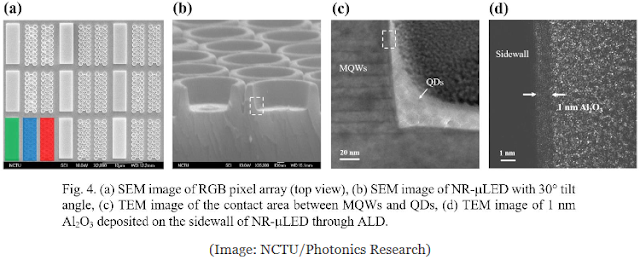ESPOO, Finland, 23rd April 2019 – Picosun Group, supplier of the leading AGILE ALD™ (Atomic Layer Deposition) thin film coating solutions, reports superb results in boosting micro-LED performance using ALD passivation.
Researchers from Taiwan’s National Chiao Tung University, China’s Xiamen University and SIJ Technology have developed a monolithic Micro LED which achieves full-color display. Through the adoption of ALD, the thin layer between multiple quantum
wells and quantum dots of NR Micro LED can be controlled and
nonradiative resonant energy transfer (NRET) for color conversion can be
maintained (LINK).
Micro-LEDs are a strong challenger to existing display technologies such as LCDs (liquid crystal displays), OLEDs (organic light-emitting diodes) or conventional LEDs (light-emitting diodes). Offering compact size, low power consumption, superior brightness, and energy efficiency, higher contrast and color saturation, ultra-high resolution, flexibility, and excellent reliability, micro-LEDs are currently actively studied and developed at the leading electronics manufacturers and R&D institutes around the world. Micro-LEDs are typically used for small screens such as those used in tablets, smartphones, and smartwatches, and the first large area displays have also been demonstrated already.
The Co-Lab collaboration signature ceremony of NCTU and Finland Picosun 2015 (LINK)
Still, the micro-LED technology has certain drawbacks that hinder its full-scale commercial breakthrough. The micro-LED screen consists of minuscule pixels producing green, blue and red light. Some steps in the manufacturing process of these pixels easily cause damage to their delicate nanometer-scale structures, which leads to loss of light intensity. ALD has now been proven to effectively fix these damages, not only restoring the light intensity but actually boosting it to superior levels. At Picosun customer site, National Chiao Tung University (NCTU), Taiwan, the light-emitting intensity of micro-LEDs has been enhanced by 143.7% by using ALD passivation layers deposited with PICOSUN™ ALD equipment(*).
“We are happy to report these great results achieved in micro-LED efficiency enhancement using ALD technology. PICOSUN™ ALD equipment has been an integral part of our facilities for a long time, and we are always impressed by their performance and the superior ALD film quality obtained with them. Picosun’s customer support is also impeccable, which is very much appreciated considering we collaborate extensively with industries. Whenever we need something regarding the equipment or process consultancy, Picosun staff is always up to date and ready to provide thorough answers,” states Professor Hao-Chung Kuo from NCTU.
“NCTU is our prestigious customer and a key partner for years already. We are glad that our ALD solutions have enabled this impressive performance boost to their micro-LEDs. Micro-LED technology has immense potential to disrupt the solid-state lighting market and our Asian customers, both in industries and R&D, will surely lead the forefront of this development,” continues Mr. Edwin Wu, CEO of Picosun Asia Pte. Ltd.
“We are happy to report these great results achieved in micro-LED efficiency enhancement using ALD technology. PICOSUN™ ALD equipment has been an integral part of our facilities for a long time, and we are always impressed by their performance and the superior ALD film quality obtained with them. Picosun’s customer support is also impeccable, which is very much appreciated considering we collaborate extensively with industries. Whenever we need something regarding the equipment or process consultancy, Picosun staff is always up to date and ready to provide thorough answers,” states Professor Hao-Chung Kuo from NCTU.
“NCTU is our prestigious customer and a key partner for years already. We are glad that our ALD solutions have enabled this impressive performance boost to their micro-LEDs. Micro-LED technology has immense potential to disrupt the solid-state lighting market and our Asian customers, both in industries and R&D, will surely lead the forefront of this development,” continues Mr. Edwin Wu, CEO of Picosun Asia Pte. Ltd.



%20(1).png)







.jpg)